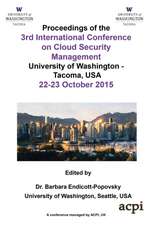Information and Meaning: An Evolutionary Perspective
Autor Tom Stonieren Limba Engleză Paperback – 15 aug 1997
Preț: 640.06 lei
Preț vechi: 753.01 lei
-15% Nou
Puncte Express: 960
Preț estimativ în valută:
122.48€ • 126.55$ • 101.89£
122.48€ • 126.55$ • 101.89£
Carte tipărită la comandă
Livrare economică 19 martie-02 aprilie
Preluare comenzi: 021 569.72.76
Specificații
ISBN-13: 9783540761396
ISBN-10: 354076139X
Pagini: 272
Ilustrații: XIII, 255 p.
Dimensiuni: 155 x 235 x 14 mm
Greutate: 0.41 kg
Ediția:Softcover reprint of the original 1st ed. 1997
Editura: SPRINGER LONDON
Colecția Springer
Locul publicării:London, United Kingdom
ISBN-10: 354076139X
Pagini: 272
Ilustrații: XIII, 255 p.
Dimensiuni: 155 x 235 x 14 mm
Greutate: 0.41 kg
Ediția:Softcover reprint of the original 1st ed. 1997
Editura: SPRINGER LONDON
Colecția Springer
Locul publicării:London, United Kingdom
Public țintă
ResearchCuprins
1 Introduction.- Philosophical Preface.- The Need for a General Theory of Information.- Knowledge Engineering.- Some Definitions and Problems.- Until Recently, Why Has Information Been Ignored?.- 2 The Nature of Information.- What is Information?.- Information and the Laws of Physics.- Shannon’s Theory of Communications.- Information and Entropy.- The Interconversion of Information and Energy.- Information as a Fundamental Property of the Universe.- Infons.- Devlin’s ‘Infons’.- The Evolution of the Universe.- The Evolution of Biosystems.- Conclusion.- 3 The Diversity of Information Processing.- Information Transductions.- The Human Social Information-Processing System.- Ants: a Model for Social Information-Processing Systems.- The Neurological Information Processing System.- The Immune System.- Maintaining Body Fluid Balance.- Other Bodily Subsystems.- Cellular Information-Processing Systems.- Mechanical Information-Processing Systems.- Physical Information-Processing Systems.- Electronic Information-Processing Systems.- General Discussion.- Conclusion.- 4 The Spectrum of Intelligence.- Intelligence: the Basic Concept.- Intelligence: a Spectrum of Phenomena.- Beyond Information: the Evolution of Intelligence.- Human Intelligence.- Sub-Human Intelligence.- Sub-Human Self-Consciousness.- Instinctive Behaviour.- Are Brains Necessary for Intelligent Behaviour?.- Is a Nervous System Necessary for Intelligent Behaviour?.- The Collective Intelligence of Microorganisms.- DNA as Memory.- Summary and Concluding Remarks.- 5 Proto-Intelligence.- Proto-Intelligence.- Some Further Thoughts About the Preconditions for Intelligence.- 6 The Origins of Bio-Intelligence.- Teilhard de Chardin’s Concept of the ‘Corpuscle’.- Forming a Bio-Corpuscle.- Is the Vesicular TheoryEnough?.- Clay Minerals and the Origin of Life.- Is the Clay Hypothesis Enough?.- Before DNA.- DNA as Part of an Information-Processing System.- Intelligence and the Control of the Environment.- Summary and Conclusion.- 7 Machine and Electronic Intelligence.- Mechanical Intelligence.- Can a House Learn?.- Deep Though and Deep Blue.- Cellular Automata Machines.- Why Computers Will Become Smarter Than People.- The Emerging Global Brain.- Neural Network Computers.- Summary and Conclusion.- 8 The Physical Origin of Meaning.- The Spectrum of Meaning.- Defining Meaning.- Which Came First: the Message or the Meaning?.- 9 The Origins of Human Speech.- Vocal Signalling Among Vervet Monkeys.- Visual Signalling.- Group Vocalization.- Laughter.- The Symbolic Capabilities of Bonobos.- The Trouble With Consonants.- Other Changes.- Language and Genetics.- The Importance of Speech in Human Evolution.- Summary and Conclusion.- 10 The Internal Information Environment.- The Internal Information Environment.- On Misunderstanding.- The Mind as a Form of Virtual Reality.- On the Nature of Understanding.- Consciousness.- Meaning as Applied to the Internal Information Environment of Cells.- 11 The Semantic Metabolism.- Hormone Message and Cellular Metabolism.- The Concept of Semantic Metabolism.- Most Cells can Act as Both Conduits and Modulators of Extra-Cellular Information.- Some Comparisons Between Cellular and Semantic Metabolism.- Semantic Metabolism in Neural Networks.- Epicentres, Gestalts and Consciousness.- Is it Possible to Quantify the Meaning of a Message?.- Summary and Conclusion.- 12 Review and Further Discussion About Consciousness.- Information.- Information Processing.- Intelligence.- Just how Advanced is Human Self-Consciousness?.- Meaning.- Defining Meaning.- The Message and the Sender.- Some Further Thoughts About Consciousness and Why it is Possible to Explain it in Reductionist Terms.- 13 How Neurons Create Thought.- The Brain as a Series of Resonating Circuits.- The Symphony Orchestra Model.- How the Brain Processes Incoming Information.- Meaning Revisited: How the Brain Decides Which Stored Information is Relevant.- How Does the Brain Transport Local Oscillations From One Part to Another?.- Human Speech Revisited.- Edelman’s Theory of Neural Darwinism Revisited.- Once Again, Semantic Metabolism and Cellular Metabolism.- Some Final Words About Information and Meaning.- A Calculations Presented in Chapter 2: The Nature of Information.- B Infons and the Relativity Equations.- C How to Evolve Electronic/Mechanical Systems into the Equivalent of a Living, Self-Reproducing Bio-System (a Self-Replicating Automated Factory).- D Some Cardinal Differences in the Anatomy and Physiology of Classical Computers and the Human Brain.- E Possibilities Considered in Chapter 11 on How to Quantify Meaning.- References.
Caracteristici
The third volume in a series designed to clarify the issues relating to the concept of information aims to help develop a science of information and study a pattern of interrelated phenomena which extends through all of nature. Covers a great breadth of intellectual territory, providing sufficient depth to give credibility to the numerous new ideas presented.





















